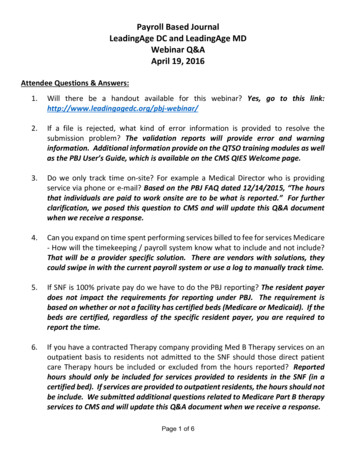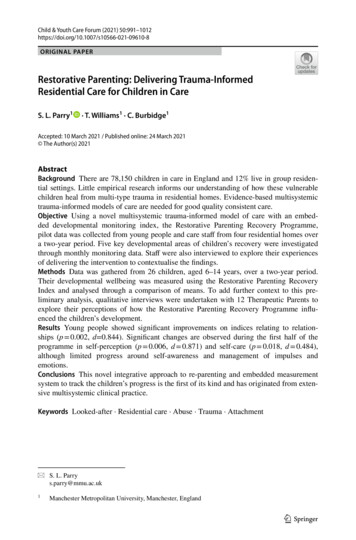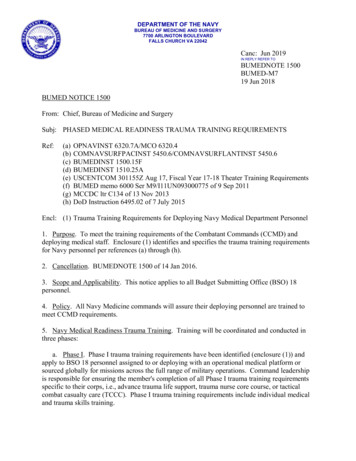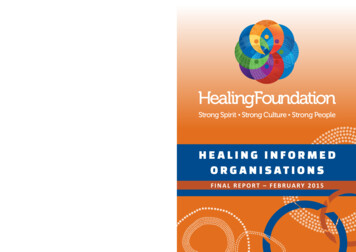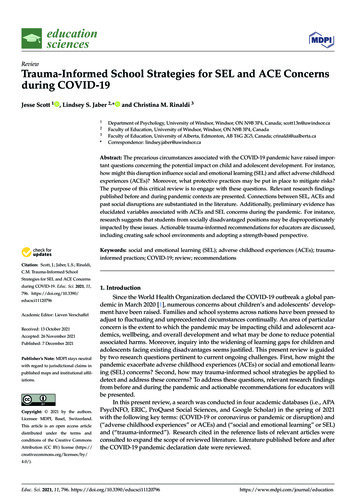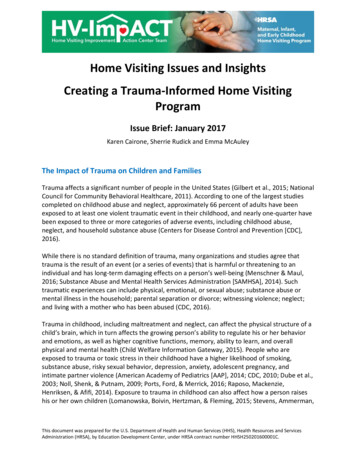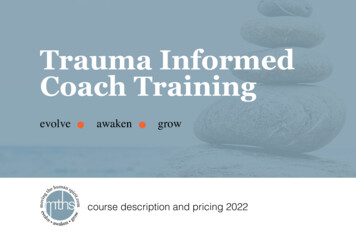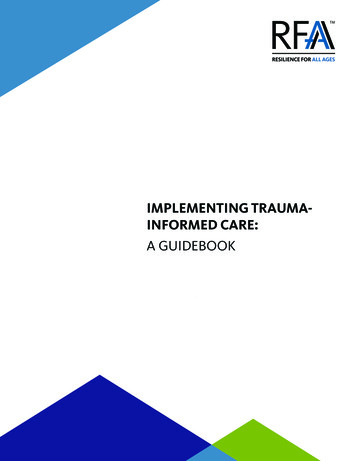
Transcription
IMPLEMENTING TRAUMAINFORMED CARE:A GUIDEBOOK
Implementing Trauma-Informed Care: A GuidebookPublished 2019 by LeadingAge MarylandBaltimore, MDCopyrightAbout LeadingAge MarylandLeadingAge Maryland is a community of more than 120 not-for-profit organizations and a widerange of collaborators united to shape the future of aging in Maryland. Our mission is to expandthe world of possibilities for aging through advocacy, education, innovation and collaboration.LeadingAge Maryland is a state affiliate of the national organization LeadingAge. Resilience for AllAges is an initiative of LeadingAge Maryland dedicated to equipping individuals and organizationsto become more trauma-informed and to advance trauma-informed work with older adults. Learnmore at www.leadingagemaryland.org.Karen Heller Key – ContributorChristy Kramer – ContributorKaren Key is President and CEO of Heller Key ManagementConsulting and serves as a Principal with Resilience for All Ages.Her career includes management roles in national nonprofithuman services organizations, including six years at thenational level with AARP, where she led the piloting of a modelfor engaging volunteers in improving the experiences of familycaregivers and of older people receiving care at home.A lifelongstudent of applied neuroscience, Karen has studied the cognitivedimensions of how trauma and traumatic stress impact thebrain’s executive function. She has worked to apply this kind ofcognitive science in human services settings, and is the co-authorof an April 2015 article in the American Public Human ServicesAssociation journal Policy and Practice exploring the applicationof trauma-informed approaches to self-care and resilience withinthe human services workforce.Christy Kramer is the Director of LeadingAge DC. A licensednursing home administrator in Maryland for 15 years, Christybegan her career as administrator of a 285 bed nursing home inGaithersburg, Maryland. Over the course of ten years, Christyparticipated in large scale projects including: leading the selectionand implementation of the electronic medical records system;the development of a culture change strategic plan; CARFCCAC accreditation; Maryland Performance Excellence Awardapplication; and Annual Licensure and Certification surveys.Christy then moved to the George Washington UniversityMaster of Health Administration program where she workedwith the long term faculty on curriculum development and NABAccreditation. In addition, she counseled students on fellowship,residency, administrator-in-training and internship programs.During this time, Christy was appointed to the Board of LongTerm Care Administrators for the District of Columbia. Christyrecieved her Bachelor's degree from Cornell University and herMaster of Health Services Administration from the GeorgeWashington University.Jill Schumann – ContributorJill Schumann is the President and CEO of LeadingAge Maryland.Prior to her work with LeadingAge Maryland she served asthe chief executive of Lutheran Services in America, one of thelargest health and human services networks in the country. Shehas created ground-breaking programs in post-acute healthcareand behavioral health, and has consulted with organizationson strategy, governance, innovation, and collaboration and is afrequent presenter at conferences.2Lisa Schiller – ContributorLisa Schiller, LCSW, is Executive Director of MHY Family Services,a trauma-informed organization. She has served in managementroles in local and national organizations. She is a long-timestudent of the practice of trauma-informed care and believes thattrauma-informed organizations benefit both clients and staffthrough the development of safe, respectful and healthy cultures.
TABLE OF CONTENTSINTRODUCTION4PRINCIPLES AND PRACTICES OF TRAUMA-INFORMED CARE:A QUICK REVIEW5PREVALENCE AND IMPACT OF TRAUMA5DEFINING KEY TERMS7CORE PRINCIPLES10LEVELS OF IMPLEMENTATION11GETTING STARTED12FORMING A TRAUMA-INFORMED CARE IMPLEMENTATION TEAM13CREATING A TRAUMA-INFORMED CARE IMPLEMENTATION PLAN15SPECIAL CONSIDERATIONS FOR NURSING HOMES17MAJOR NEUROCOGNITIVE DISORDERS/DEMENTIA18PHYSICIANS AND CONTRACTED HEALTH PROFESSIONALS19RELATIONSHIP TO PERSON-CENTERED/DIRECTED CARE20BEHAVIORAL HEALTH RESOURCES21IMPLICATIONS FOR SHORT AND LONG STAY RESIDENTS22STAFF AND TRAUMA23FAMILIES AND TRAUMA25POLICIES AND PROCEDURES27RESOURCES28STATEMENT OF INTENT28PRELIMINARY ORGANIZATIONAL ASSESSMENT29TRAUMA-INFORMED CARE IMPLEMENTATION TEAM FORMATIONWORKSHEET32IMPLEMENTATION PLAN CHECKLIST33LEADING CHANGE35GETTING THE BOARD 'ON BOARD'37STAFF KNOWLEDGE: PRE- AND POST- TEST38ENDNOTES423
INTRODUCTIONImplementing Trauma-Informed Care: A Guidebook is the second in aseries of tools and resources from Resilience for All Ages designedto assist nursing homes seeking to become trauma-informedorganizations.The first, Foundations of Trauma-Informed Care, is a toolkit thatincludes: Foundation of Trauma-Informed Care: A Primer Six one-page lessons for staff Two slide presentations with notes to be used forpresentations and training A User GuideIt will be helpful to become familiar with the Foundations beforemoving to implementation planning.This Guidebook focuses on trauma-informed care implementation.It contains: A quick review of the basics of trauma and trauma-informedcare An explanation of the levels of implementation and theGuidebook focus on Level One Steps to create an implementation plan and form animplementation team Special considerations for nursing homes A variety of resources for implementationTraining and webinar resources are available from Resilience for AllAges and additional tools will be available in the months to come.4
IMPLEMENTING TRAUMA-INFORMED CARE: A QUICK REVIEWPRINCIPLES AND PRACTICES OFTRAUMA-INFORMED CAREA Quick ReviewWhile this section will summarize basic informationregarding trauma-informed care, it is importantthat those using this guidebook will first have readthe Resilience For All Ages publication, Foundationsof Trauma-Informated Care: An IntroductoryPrimer.1In 2016 the Center for Medicare and MedicaidServices issued a set of changes to the requirementsfor nursing home communities that participatein Medicare and Medicaid programs.2 Among themany changes finalized in this rule are policiesdesigned to strengthen the provision of personcentered care to residents.3 Person-centered caretakes a holistic approach to meeting the needs ofeach individual resident, and considers psychosocialand spiritual aspects of well-being in addition tophysical health. While the term “person-centered”mirrors CMS language, many nursing home leadersaspire to what might better be described as persondirected services and supports, characterized bya recognition of residents’ rights to care that isshaped to meet their preferences and goals to thegreatest extent possible.In order to provide this kind of care to all residents,nursing home communities must be equippedto understand and work with the circumstances,needs, and wishes of people who bring with them awide variety of backgrounds and lived experiences.Accordingly, the new Requirements of Participationinclude an emphasis on providing services thatare culturally competent — reflecting culturalawareness and humility — and that are sensitiveand responsive to the special needs of residentswho have experienced trauma.The inclusion of a focus on trauma-informed carereflects increasing recognition that the experienceof trauma is widespread across the population andhas significant long term consequences for healthand well-being. This recognition has led to thedevelopment of approaches addressing the impactof trauma, some of them involving trauma-specifictreatment, and others involving creating conditionsthat are sensitive to the impact of trauma and toavoiding re-traumatization.While children’s services, behavioral health, violencereduction initiatives, and programs for people whoare veterans and Holocaust survivors have beenpracticing trauma-informed work for more than adecade, the field of aging services has come to thework of treating trauma only recently. The goal is tocreate safe environments for older people (and staffmembers) so that all services, supports and careoffered — including all medical care, enrichmentand socialization services — factor in the reality thatsome residents (and staff members) will responddifferently because of trauma histories, and willbenefit from having those offerings provided intrauma-informed ways.Prevalence and Impact of TraumaWhile Americans once considered trauma to be arelatively infrequent occurrence, most researchfinds that a majority of us — somewhere between55% and 90% by some measures — have experiencedat least one traumatic event.4,5 Potentially traumaticexperiences include: experiencing or witnessingchildhood adverse events (e.g. experiencing orwitnessing emotional, physical or sexual abuse orneglect, living with a parent with mental illness orsubstance misuse disorder, death or absence of aparent because of imprisonment); domestic andsexual violence; natural disasters; car, train andairplane crashes; combat; becoming a refugee;homelessness; medical trauma; violent crime;bias and discrimination; and hate crimes and hatespeech.5
IMPLEMENTING TRAUMA-INFORMED CARE: A QUICK REVIEWPrevalence and Impact of Trauma Continued.A potentially traumatic event is any powerful eventthat affects a person’s daily life. While not all peoplewill experience these events as traumatic, the realitythat these kinds of events can be traumatizing isessential to bear in mind, given the impact thattraumatic stress has on human health and wellbeing.Stress vs. Traumatic StressAll human beings react to some external stimuliwith a stress response, ranging from the physical tothe emotional and to the cognitive and behavioral.Traumatic stress refers to “the emotional, cognitive,behavioral and psychological experiences ofindividuals who are exposed to, or who witness,events that overwhelm their coping and problemsolving abilities.”6 In other words, a trauma, whichproduces traumatic stress, occurs when our copingmechanisms are overwhelmed by outside events.Over the course of their lives, many older peoplehave experienced one or more of the potentiallytraumatic events and experiences described above— and the impact of that earlier trauma does notdisappear with age. Of course older people aresubject to these events in the present as well asthe past, and so may have more recent or currenttraumas of these kinds with which to contend.Older people may also experience traumas relatedto the aging process itself, including the loss ofloved ones, of their own capacities (physical andmental), loss of roles and identity and of theirhome, and increased dependence on caregivers.Experiences of neglect and of elder abuse are alsoimportant to consider. These losses may look like"normal" grieving, or may result in a traumaticstress response.6A majority of us —somewhere between55% and 90% by somemeasures — haveexperienced trauma.
IMPLEMENTING TRAUMA-INFORMED CARE: A QUICK REVIEWDefining Key TermsThe Three E’s of TraumaWhile it is anticipated that CMS will be providingmore detailed guidance, currently CMS is pointingnursing home leaders to the principles set forthin a 2014 SAMHSA resource entitled SAMHSA’sConcept of Trauma and Guidance for a TraumaInformed Approach.7 Accordingly, while there aremany definitions of key terms offered throughoutthe literature on trauma, traumatic stress andtrauma-informed care, those offered here are basedon the SAMHSA resource. Please note that in orderto make the SAMHSA guidance relevant to olderpeople and to long term care settings, we havemade minor modifications to terms used in theoriginal publication.The Three E’s of Trauma are event(s), experience ofevent(s), and effect.TRAUMAIndividual trauma results from anevent, series of events, or set ofcircumstances that is experiencedby an individual as physically oremotionally harmful or life threateningand that has lasting adverse effectson the individual’s functioning andmental, physical, social, emotional, orspiritual well-being.EVENTS — can include actual or extreme threat ofharm, or severe, life-threatening neglect for a child.Events can occur once or repeatedly over time.Traumatic events can occur throughout a lifetime.EXPERIENCE — how the individual experiences anevent helps determine if it is a traumatic event.Factors include:How an individual assigns meaning to theeventHow the individual is disrupted physicallyand psychologically by the eventThe individual’s experience of powerlessnessover the traumatic event, which can triggerfeelings of humiliation, shame, guilt, betrayaland/or silencing, isolation, shattering oftrust, and fear of reaching out for helpCultural beliefs (e.g. about the role ofwomen), availability of social supports,and age and developmental stage of theindividual at the time of the eventEFFECT — adverse effects can occur immediatelyor after a delay, and can have a range of duration.Individuals may not recognize the connectionbetween traumatic events and their effects.Adverse effects include:Inability to cope with normalstresses of daily livingInability to trust and benefit fromrelationshipsCognitive difficulties — memory,attention, thinking, self-regulation,controlling the expression of emotions7
IMPLEMENTING TRAUMA-INFORMED CARE: A QUICK REVIEWTRAUMA-INFORMEDA program, organization or system that is trauma-informed realizes the widespread impact of traumaand understands potential paths to recovery; recognizes the signs and symptoms of trauma in clients,families, staff and others involved with the system; and responds by fully integrating knowledge abouttrauma into policies, procedures and practices to actively resist re-traumatization.The Four R’s of a Trauma-InformedApproachA trauma-informed approach can be understoodthrough the terms realization, recognition,responding, and resisting.REALIZATION — all those involved in yourorganization at all levels realize that:Trauma can affect individuals, families,organizations and communitiesPeople’s behavior can be understoodas coping strategies designed tosurvive adversity and overwhelmingcircumstances (past or present)RECOGNITION — all those involved in yourorganization are able to recognize the signs oftrauma and have access to trauma screening andassessment tools.RESPONDING — your organization responds byapplying a trauma-informed approach to all aspectsof your work. Specifically, everyone on staff in everyrole has changed their behaviors, language andpolicies to take into consideration the experiencesof trauma among residents, their families and staff.8Other ways this response is manifest include:Ensuring that the materials used in yourorganization — from your mission statementto manuals to policies and procedures —reflect your commitment to creating aculture of resilience, recovery and healingfrom traumaFormalizing ways for people who haveexperienced trauma to advise and guide theorganizationProviding staff training and guidance forsupervisors on secondary traumatic stressArticulating your commitment to a physicallyand psychologically safe environment- including employees and supervisors fairness and transparency (others wouldinclude a culture of social and moral safety)Adopting a universal precautions approachthat assumes the presence of trauma in thelives of residents and employees and takessteps to not replicate traumaRESISTING — re-traumatization of residents andstaff members by ensuring that practices donot create a toxic environment — for example,understanding the impact of using restraints orseclusion on a resident with a trauma history.
IMPLEMENTING TRAUMA-INFORMED CARE: A QUICK REVIEWThe Six Key Principles of a TraumaInformed ApproachSAFETY — all people associated with theorganization feel safe. This includes the safety ofthe physical setting and the nature of interpersonalinteractions.TRUSTWORTHINESS AND TRANSPARENCY —your organization is run with the goal of buildingtrust with all those involved.PEER SUPPORT — support from other traumasurvivors is a key to establishing safety and hope.Peer support may be from others in the community.COLLABORATION AND MUTUALITY—recognition that everyone at every level canplay a therapeutic role through healing and saferelationships. Your organization emphasizesthe leveling of power differences and taking apartnership approach with staff.EMPOWERMENT, VOICE, AND CHOICE — yourorganization recognizes and builds on the strengthsof people — staff members and residents. Yourecognize the ways in which nursing home residentsand staff members may have been diminished invoice and choice and have at times been subject tocoercive treatment. You support and cultivate skillsin self-advocacy, and seek to empower residentsand staff members to function or work as well aspossible with adequate organizational support.CULTURAL, HISTORICAL, AND GENDERISSUES — your organization actively moves pastcultural biases and stereotypes (gender, region,sexual orientation, race, age, religion), leveragesthe healing value of cultural traditions, incorporatesprocesses and policies that are culturally aware, andrecognizes and addresses historical trauma.KEY PRINCIPLES OF A TRAUMAINFORMED APPROACHSafetyTrustworthiness & TransparencyPeer SupportCollaboration & MutualityEmpowerment, Voice, & ChoiceCultural, Historical, & Gender IssuesThe Ten Domains for Implementing aTrauma-Informed ApproachSAMHSA has outlined ten domains of organizationalfunctioning that should be addressed whenimplementing trauma-informed care. As is evident,they involve the entire organization. Those domainsare:Governance and LeadershipPolicyPhysical EnvironmentEngagement and Involvement — of peoplein recovery, trauma survivors, residents andfamily members, and staff at all levelsCross-Sector Collaboration — all levels,departments, and teamsScreening, Assessment, Treatment ServicesTraining and Workforce DevelopmentProcess Monitoring and Quality AssuranceFinancingEvaluation9
IMPLEMENTING TRAUMA-INFORMED CARE: A QUICK REVIEWCore PrinciplesThere are three core principles that guide traumainformed care:1. The impact of adversity is not a choice.2. Understanding adversity helps us makesense out of behavior.3. Prior adversity is not destiny.PRINCIPLE 1: THE IMPACT OFADVERSITY IS NOT A CHOICE.Adverse or difficult life experiences affect all of us inways that are more about neurophysiology and lessabout character than most of us have supposed.Despite the commonly shared belief that ‘whatdoesn’t kill us makes us stronger,’ the evidencefrom neurobiology and public health increasinglydemonstrates that adversity causes changes in thebrain and body that occur outside our awarenessand are not subject to being overridden by ‘grit’ ortoughness.PRINCIPLE 2: UNDERSTANDINGADVERSITY HELPS US MAKE SENSE OUTOF BEHAVIOR.We cannot fully understand behavior or respond toit effectively without understanding prior adverseexperiences.In working with older adults, clinical and non-clinicalstaff members are continuously — consciouslyand deliberately or unconsciously — observingbehavior and interpreting what that behaviormeans. Some of this is an ongoing process with allhuman interactions. Some of this observation andmeaning-making comes from the training that staffmembers receive in their professional disciplines.When considering what observed behavior mightmean, we use a number of different rubrics, amongthem considerations about possible medicalreasons, psychosocial causes, and environmentalfactors.10However, the capacity to assess the meaningof behavior is incomplete without the additionof a consideration of prior adversity. A traumainformed approach to assessing behavior does nottake precedence over other rubrics — it adds anessential missing piece to the puzzle that can helpmake sense out of puzzling behavior and informsour understanding about why our interventionssometimes are ineffective or even backfire.PRINCIPLE 3: PRIOR ADVERSITY IS NOTDESTINY.In an environment of safety and support, change,healing and better lives are possible.There are two key dimensions to emphasizeregarding the potential for older people whohave experienced adversity to thrive: the roleof individual human potential and the role of asupportive environment.Human potential for healing across the lifespan:Beyond the evidence and practice wisdom frommultiple fields that focus on the physical, mentaland spiritual health of individuals, there exists dataon the impact of psychological interventions witholder adults. This includes the kinds of traumaspecific interventions that may be offered throughbehavioral health services, along with insightsfrom neurobiology that help explain how greaterresilience and healing is possible even after thebrain is impacted by traumatic stress.The role of a safe and supportive environment:Because adverse or traumatic experiences, bydefinition, are the result of a lack of safety andmake individuals susceptible to feeling unsafe,subsequent environments have the potential toeither exacerbate the feeling of threat and dangeror mitigate it. A safe environment creates a settingin which manifestations of traumatic stress areminimized and individuals experience greatercomfort and opportunity for well-being and healing.
IMPLEMENTING TRAUMA-INFORMED CARE: LEVELS OF IMPLEMENTATIONLEVELS OF IMPLEMENTATIONWhen an organization makes a commitment toimplement trauma-informed care, it is beginninga multi-year, multi-dimensional process of change.For nursing homes participating in the Medicareand/or Medicaid programs, CMS has mandatedtrauma-informed care in the Phase 3 (November2019) Requirements of Participation.The research and practice of trauma-informed care insettings that provide supports and services to olderadults is still in its infancy. Very few organizationsin this field are familiar with the concepts, let alonehow they can be translated into the daily life of theorganization. Therefore, it is likely that even the mostcommitted organizations will move through levelsof implementation, deepening their understandingand application over a period of years. Hopefully,a community of research and practice will developto build shared learning about effective approachesand evidence-based resources.1Each organization will need to tailorimplementation to its particular circumstancesand resources. The first level of implementationwill likely involve:Engaging in basic education regarding traumainformed careEstablishing a multi-disciplinary team to guideimplementationConducting a preliminary organizationalassessment and setting prioritiesMaking basic changes to policies and proceduresto reflect a trauma-informed approachIdentifying mental/behavioral health experts intrauma to whom older adults, family membersand staff members may be referred as neededIdentifying ways to create a sense of safety forclients and staffBeginning to grasp what a truly trauma-informedorganization might look like2As organizations progress to a greaterintegration of a trauma-informed approach,the second level of implementation will likelyinvolve:Recognizing the need for significant culturechange that reflects a greater degree oftransparency, respect and empowerment forclients, families and staff membersTranslating the principles of trauma-informedcare to the work of each department and staffmemberIdentifying and addressing overt and covertbarriers to a more robust trauma-informedapproachCommunicating the implications of traumainformed care: to firms who provide relatedservices such as therapy and pharmacy; toclients and family members; and to the widerpublicBecoming more deeply aware of the effectsof primary and secondary trauma for staffmembers and increasingly engaging with peoplewith lived experience of trauma3And, moving forward, organizations trulycommitted to trauma-informed care may:Become part of learning communities thatengage in applied research and share bestpracticesIdentify measures of progress and continuallystretch themselvesIncrease staff training and learning abouttrauma-informed careStrengthen behavioral health and peer supportnetworksConnect to trauma issues in the widercommunity11
IMPLEMENTING TRAUMA-INFORMED CARE: GETTING STARTEDGETTING STARTEDAs your organization begins to implement trauma-informed care, the senior team must make it clear that theyare invested in, and committed to, trauma-informed care.The Substance Abuse and Mental Health Services Administration (SAMHSA) indicates that implementingtrauma-informed care requires change at many levels of an organization and, therefore, has identified tendomains that should be addressed:1. Governance and Leadership2. Policy3. Physical Environment4. Engagement and Involvement5. Cross-Sector Collaboration6. Screening, Assessment, Treatment Services7. Training and Workforce Development8. Process Monitoring and Quality Assurance9. Financing10. EvaluationSAMHSA has outlined a series of questions organizations can use to stimulate their thinking in each of thedomains as they implement trauma-informed care.8 This document is available at: dfGetting Started Checklist:Senior leaders can take the following steps to get started with trauma-informed care implementation:Read and discuss:Foundations of Trauma-Informed Care: A PrimerRelevant sections of the CMS Requirements of ParticipationSAMHSA Guiding Principles of Trauma-Informed CareAny updated guidance from CMSSenior Team (and relevant others such as the Board of Directors) discuss and commit to a Statementof Intent (page 28)Form a Trauma-Informed Care Implementation Team (page 13 and page 32)Establish the Trauma-Informed Care Team’s Scope of Work and Budget (page 14)Conduct a Preliminary Organizational Assessment (page 29)Create a plan to address the results of the Preliminary Organizational Assessment (in conjunctionwith the Trauma-Informed Care Implementation Team)Identify local behavioral health resources and Employee Assistance Program resources. Share yourorganization’s commitment to trauma-informed care and the ways in which they may support it(page 21)Review relevant local and state mandated abuse reporting requirementsDevelop and implement policies and procedures to support trauma-informed care (in conjunctionwith the Trauma-Informed Care Implementation Team) (page 27)Educate all staff members regarding the basics of trauma-informed care (page 38)12
IMPLEMENTING TRAUMA-INFORMED CARE: FORMING A TRAUMA-INFORMED CARE TEAMFORMING A TRAUMA-INFORMED CAREIMPLEMENTATION TEAMAs with any significant change, implementingtrauma-informed care will require a group of wellinformed and enthusiastic champions. A TraumaInformed Care Team will work together to plan forimplementation and then guide the roll-out andongoing development and periodic evaluation.As you think aboutspecific people to involve,identify individuals whoare natural leaders andwho are respected by theirpeers.While the Team might be led from someone fromsocial work, nursing, or special projects, it will beimportant to have the nursing home administratoron the team to ensure that all departments areengaged and involved. The Executive Director,CEO, or other end-point decision maker for thecommunity will likely not participate directly inthe implementation team, but it is critical that thisperson be knowledgeable about trauma-informedcare and send the clear and consistent message thatthey are committed to creating a trauma-informedorganization.The Trauma-Informed Care Team needs to besmall enough to be able to learn together, meetregularly and act nimbly. It must be large enough toinvolve the perspectives of individuals from variousdisciplines and levels of the organization. A rangeof seven to ten people on the team generally workswell. In a nursing home setting, you will want tohave people on the Team from:Nursing/ClinicalSocial WorkHuman ResourcesDirect CareSpiritual life/ChaplaincyEnvironmental ServicesIt is wise to invite a Certified Nursing Assistantor other direct service worker and to considerindividuals from other departments as well – andto include employees from different levels of theorganization. Experiential work has shown that it isbest to form a separate team rather than assigningthe implementation of trauma-informed care toan existing group such as quality improvement orsafety committees.9As you think about specific people to involve,identify individuals who are natural leaders andwho are respected by their peers. People who havealready proven themselves supportive of personcentered care and who are open to change makegood candidates for the Team. As you speak withpotential Trauma-Informed Care Team members,be aware that staff members may bring their owntrauma histories. You do not need to delve intopeople’s personal lives, but do make sure to beclear that it is fine to decline the invitation with norepercussions.Initial commitments of Team members should befor a minimum of six months to assure continuityand effective team work. Later, other individualsmay be identified as natural champions for traumainformed care, or some Team members may needor choose to leave the Team. As staff members areeducated about trauma-informed care the Team willwant to develop a clear and transparent process foridentifying new Team members.13
IMPLEMENTING TRAUMA-INFORMED CARE: FORMING A TRAUMA-INFORMED CARE TEAMThe Trauma-Informed Care TeamCharterThe Team will design and guide the implementationof trauma-informed care.Nursing/ClinicalSocial rect CareSpecific responsibilities may include:Perform a preliminary organizationalassessmentCreate an implementation plan to includetasks, timelines, responsibilities andmilestonesConsider what resources will be requiredIdentify and address barriers toimplementationEnsure that all staff members have a basicknowledge of
to assist nursing homes seeking to become trauma-informed organizations. The first, Foundations of Trauma-Informed Care, is a toolkit that includes: Foundation of Trauma-Informed Care: A Primer Six one-page lessons for staff Two slide presentations with notes to be used for presentations and training A User Guide

